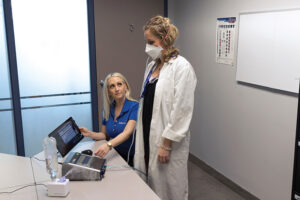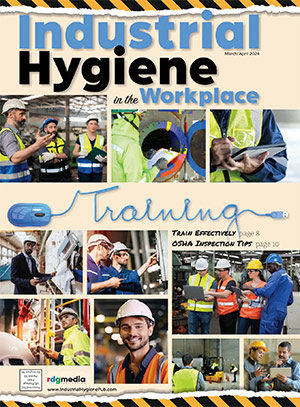Best Practices for Effective Respirator Fit Testing in a Post-COVID World
By: Rob Brauch, Contributor
Respiratory protection equipment (RPE) is a subset of PPE that has undergone rapid evolution and mass adoption during the recent global pandemic. New styles and types of RPE have been added to an already vast array of available products.
When the SARS CoV-2 virus began circulating the globe, killing thousands of people each week, the world stood up and took notice. It became apparent early on that not only was there a global shortage of respirators, but there was also a great deal of confusion as to the types of RPE available, as well as their effectiveness and ability to help stop transmission of COVID. It’s reasonable to say that COVID has dramatically changed society’s awareness of and relationship with RPE and elevated the importance of testing its performance characteristics, both at time of manufacture and in day-to-day use. Remember, even the highest performing respirators will be of no protective value if the face seal is broached to any significant degree.
Long before COVID, the role of tight-fitting respirators in preventing or minimizing human exposure to chemical, biological, radiological and a myriad of other toxic substances is well-understood and accepted by industrial hygienists, safety professionals and regulatory bodies around the world.
Respiratory Protective Equipment and COVID

Respirator fit testing, per OSHA CFR 1910.134, has been a mandatory part of all compliant Respiratory Protection Programs in the U.S. Both qualitative and quantitative methods are allowed by OSHA. (photo courtesy Rob Brauch, Accutec )
Performance of readily available classes and forms of RPE can vary a great deal, based on the demands of the application, (N95 vs. SCBA) and pre-COVID, this was generally consistent with labels showing recognized performance certifications and approvals. This was primarily based on third-party certification testing to established standards, such as that performed by CDC/NIOSH at the National Personal Protection Technology Laboratory, or NPPTL. This is assuming the respirators do not “leak” during actual use.
That held true until counterfeit RPE started showing up. Unscrupulous suppliers began producing so-called respirators that appeared to be compliant and were even labeled as such, when in fact they were not capable of protecting the wearer from airborne transmission of the virus or other hazards. This abhorrent behavior by a small group of unethical “entrepreneurs” was something I believe safety and health professionals had not witnessed on such a scale before—if ever—and, while we can hope it’s never seen again, we can take steps to ensure that quality and performance standards for RPE are met.
Many of the things learned about respirator performance during the pandemic applied directly to the area of respirator fit testing—for a number of critical reasons. Perhaps the primary reason is the urgent need to protect large numbers of first responders, caregivers and others who previously may not have been issued RPE for their daily work routines.
Respirator fit testing, per OSHA CFR 1910.134, has been a mandatory part of all compliant Respiratory Protection Programs (RPPs) in the U.S. Both qualitative and quantitative methods are allowed by OSHA, and quantitative methods can use either the Condensation Nuclei Counting (CNC) technique or the Constant Negative Pressure (CNP) technique.
Qualitative methods, using a sweet or bitter challenge agent, such as Saccharin or Bitrex®, always rely on the test subject’s sensory response—such that, if these aerosolized materials are infiltrating a poorly fitting or poorly performing respirator, the subject will sense it and alert the test administrator—resulting in a failed fit test. Quantitative methods rely on an instrument that is purpose-built for performing a measurement to objectively determine if the “fit factor” meets the requirements for the class of respirator being tested.
Qualitative fit testing has been used extensively in part due to the perceived cost of acquiring and operating a quantitative fit-test device, despite the fact that studies indicate that, when administered correctly per the OSHA protocol, there is a significant human cost in terms of both time spent for each test, as well as the risk of repetitive motion injury to the administrator, who may be required to squeeze a manual nebulizer thousands of times per day. Add in the amount of work needed to decontaminate a qualitative fit-test hood, and you have a lot of manual work that interferes with getting a good result in a reasonable amount of time.
When COVID started to hit the workforce in large numbers, however, it became apparent that one of the early onset symptoms, anosmia/hyposmia and ageusia/hypogeusia (full or partial loss of the sense of smell and taste, respectively), could hinder the subject’s ability to accurately respond to the challenge agent(s). Adding in that these symptoms typically occur very early in the infection cycle, where the subjects would still register as negative in a COVID antigen or PCR test, and you can see why there was concern regarding the use of subjective response as a valid indicator of sufficient fit. A session related to this topic was presented by the author of this article at AIHce 2021 (held virtually) titled “Implications of Anosmia and Hyposmia on the Accuracy of Qualitative Respirator Fit Testing.”
Further research needs to be done, but removing the subjective response and using a measuring instrument to determine the fit factor would seem to be more in line with accepted exposure sampling methods used by IHs for decades. Think about that: when was the last time you asked a worker “was the noise you heard above 85 dB(A),’” instead of using a dosimeter or sound level meter to objectively measure their environment?
Reducing Respirable Particles in the Air

Many of the things learned about respirator performance during the pandemic applied directly to the area of respirator fit testing. (photo courtesy Adobe Stock Images)
Qualitative fit testing was not the only method that saw an impact on the fit-test process, however. Another outcome of COVID is the intense focus put onto air handling/HVAC systems, with greatly increased installation of HEPA filtration to try to stop the airborne dispersion of the virus indoors. Vastly reducing the number of respirable particles in the building can have an impact on the operation of quantitative fit-test devices using the CNC method. These devices utilize the ambient concentration of respirable particulates in the air as the challenge agent, to both the seal and filtration media (in the case of N95, FFP3 and other disposable tight-fitting respirators). Fortunately, this issue can easily be overcome with the newest CNC technology by using a particle generator to supply sufficient levels or aerosol matter. CNP devices are unaffected by this, but the CNP method is incapable of testing ANY N95, FFP series or KN95 respirators, as those respirators cannot form an airtight seal—by design.
To be sure, the long-running debate about whether quantitative fit testing is preferable to qualitative testing will not go away just because of COVID, but an interesting development that was already underway in other parts of the world could have extreme relevance to how we in the U.S. and elsewhere approach the entire fit-test process and procedure. This has to do with certification of the test administrator.
As early as 2014, it was announced in the UK that a fit-test accreditation body, called Fit2Fit, was formed with the mission of certifying that all persons performing fit tests had been through a comprehensive training program to ensure quality and consistency of the procedure, whether it be qualitative or quantitative. This is no different than obtaining CAOHC certification for those who are administering hearing tests to prove that they comply with the requirements for producing OSHA required audiograms for workers who are included in a Hearing Conservation Program.
It seems somewhat incongruous to this author that this requirement must be in place for hearing tests but not respirator fit tests, since although hearing loss is devastating to the afflicted worker and is a compensable injury under OSHA, it does not result in death or terminal illness—as can be the case with a worker wearing an incorrectly fitted respirator. And as quantitative fit-testing equipment continues to evolve with new capabilities, such as wireless control of particle generators to optimize the ambient levels, technicians and test givers need to be aware of their proper use, just as would a certified hearing test provider. Others around the world appear to agree; countries like Australia and New Zealand are joining the growing list of places where similar accreditations are being issued or being considered.
Future of Fit Testing
All in all, the challenges respiratory protection program managers face in dealing with proper fitting and use of RPE during a pandemic cast a more intense light on the methods, machines and manpower needed to protect workers from all forms of respiratory hazards. Suppliers of fit-test products and instruments will continue to innovate, and expectations will grow regarding the certification of practitioners and administrators. Together, the IH community and other stakeholders will all play pivotal roles in assuring that the next global pandemic or other unexpected events will be met with even stronger understanding and application of the science, technology and methods needed to do the job right.
Share on Socials!
ChemRest Know You’re Protected
Upgrade Respiratory Protection—Now!
Monitoring for Asbestos
Leaders in Industrial Hygiene
Council for Accreditation in Occupational Hearing Conservation (CAOHC)
Subscribe!
Sign up to receive our industry publications for FREE!










